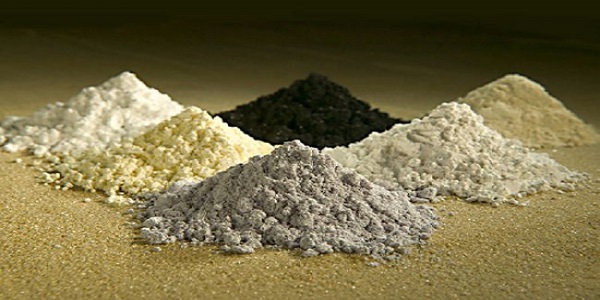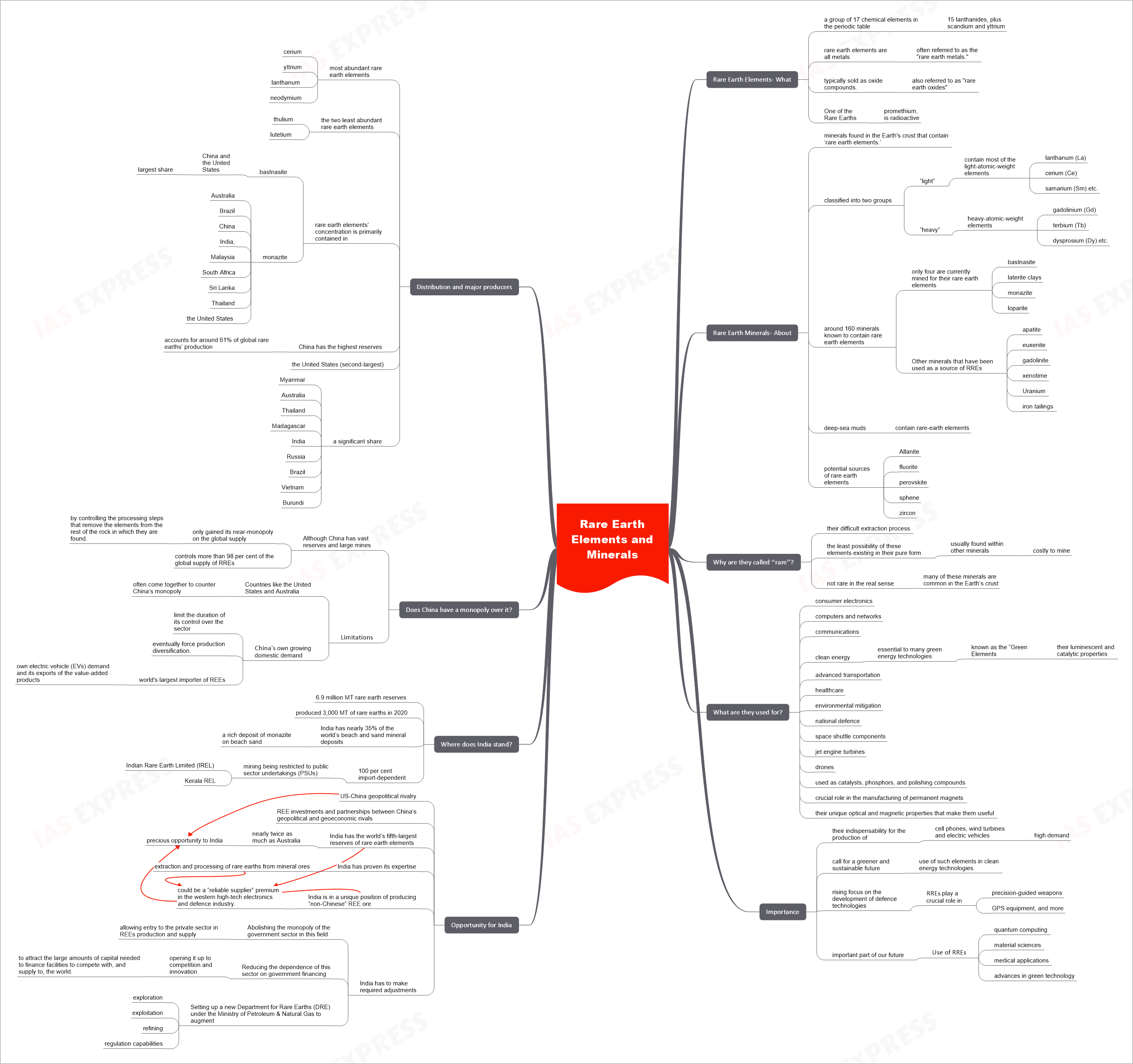Rare Earth Elements and Minerals – Uses, Major Producers and India’s Position

From Current Affairs Notes for UPSC » Editorials & In-depths » This topic
IAS EXPRESS Vs UPSC Prelims 2024: 85+ questions reflected
In recent days, the international politics and proxy disinformation campaigns between China and the US over the production of rare earth minerals have brought into the limelight the importance of such minerals for the entire world. The issue also highlights how the demand and supply for such minerals may affect the equations between various nation-states in the coming days.
Rare Earth Elements – What
- Rare Earth Elements (REEs) are a group of 17 chemical elements in the periodic table, 15 lanthanides, plus scandium and yttrium.
- The two elements scandium and yttrium are included in the list because they tend to occur in the same ore deposits as the lanthanides and have similar chemical properties.
- The 17 Rare Earth Elements are cerium (Ce), dysprosium (Dy), erbium (Er), europium (Eu), gadolinium (Gd), holmium (Ho), lanthanum (La), lutetium (Lu), neodymium (Nd), praseodymium (Pr), promethium (Pm), samarium (Sm), scandium (Sc), terbium (Tb), thulium (Tm), ytterbium (Yb), and yttrium (Y).
- The rare earth elements are all metals and thus the group is often referred to as the “rare earth metals.”
- These metals have many similar properties, and that often causes them to be found together in geologic deposits.
- They are also referred to as “rare earth oxides” because many of them are typically sold as oxide compounds.
- One of the Rare Earths, promethium, is radioactive.
Rare Earth Minerals – About
- Rare Earth Minerals are those minerals found in the Earth’s crust that contain ‘rare earth elements.’
- However, the content of the individual rare-earth elements varies considerably from mineral to mineral and from deposit to deposit, these are classified into two groups, “light” and “heavy”.
- The “light” rare earth minerals contain most of the light-atomic-weight elements such as lanthanum (La), cerium (Ce), samarium (Sm) etc.
- The “heavy” one includes the heavy-atomic-weight elements such as gadolinium (Gd), terbium (Tb), dysprosium (Dy) etc.
- There are around 160 minerals known to contain rare earth elements.
- However, only four are currently mined for their rare earth elements which are bastnasite, laterite clays, monazite and loparite.
- Other minerals that have been used as a source of rare earth elements are apatite, euxenite, gadolinite, and xenotime.
- Uranium and iron tailings have also been used in the past as a source of some of the rare earth elements.
- There are some deep-sea muds such as that near Minami tori Island, Japan that contain rare-earth elements.
- The high concentration of these muds in some places may one day be a source of rare earth elements.
- Allanite, fluorite, perovskite, sphene, and zircon have the potential to be future sources of rare earth elements.
Why are they called “rare”?
- It is their difficult extraction process and the least possibility of these elements existing in their pure form (usually found within other minerals, making them costly to mine); that they are termed as “rare” minerals.
- Despite being called “rare”, they are not rare in the real sense rather many of these minerals are common in the Earth’s crust.
What are they used for?
- They are used for a wide range of products especially being important in technologies of consumer electronics, computers and networks, communications, clean energy, advanced transportation, healthcare, environmental mitigation, and national defence, among others.
- They are also used in space shuttle components, jet engine turbines, and drones.
- It is their unique optical and magnetic properties that make them useful for such technologies.
- They are also used as catalysts, phosphors, and polishing compounds.
- They play a crucial role in the manufacturing of permanent magnets and thus their use in such technologies is the largest and most significant one.
- They are also known as the “Green Elements” because they are essential to many green energy technologies.
- These are used in high and “green” products because of their luminescent and catalytic properties.
- With the growing popularity of hybrid cars and other green products, rare earth elements are becoming more and more important to manufacturing.
Importance
- The use of rare earth elements and their indispensability for the production of cell phones, wind turbines and electric vehicles has given rise to its high demand.
- The use of such elements in EVs and other clean energy technologies further makes it important in present times when the call for a greener and sustainable future is on the table.
- With the rising focus on the development of defence technologies in recent times, the demand for rare earth elements has risen exponentially.
- Rare earth elements play a crucial role in defence technologies, especially in precision-guided weapons, GPS equipment, and more.
- Rare earth elements are likely to remain an important part of our future—from quantum computing and material sciences to medical applications and advances in green technology.
Distribution and major producers
- As mentioned earlier, rare earth elements are not as “rare” as their name implies.
- Data shows that thulium and lutetium are the two least abundant rare earth elements but each has an average crustal abundance that is nearly 200 times greater than the crustal abundance of gold.
- The most abundant rare earth elements are cerium, yttrium, lanthanum and neodymium having average crustal abundances being similar to commonly used industrial metals such as chromium, nickel, zinc, tin, and lead etc.
- The rare earth elements’ concentration is primarily contained in bastnasite and monazite.
- China and the United States have the largest share in bastnasite deposits.
- Australia, Brazil, China, India, Malaysia, South Africa, Sri Lanka, Thailand, and the United States have high monazite deposits.
- China has the highest reserves of rare earth minerals at 44 million MT. The country was also the world’s leading rare earths producer in 2020 by a long shot, putting out 140,000 MT.
- It accounts for around 61% of global rare earths’ production.
- Countries like the United States (second-largest), Myanmar, Australia, Thailand, Madagascar, India, Russia, Brazil, Vietnam and Burundi have also a significant share in rare earths’ production.
Does China have a monopoly over it?
- Although China has vast reserves and large mines containing rare earth minerals, it has only gained its near-monopoly on the global supply of rare earth elements by controlling the processing steps that remove the elements from the rest of the rock in which they are found.
- Countries like the United States and Australia have often come together to counter China’s monopoly.
- However, China still controls the vast majority of all rare earth production, and for some key medium and heavy rare earth elements such as dysprosium and terbium, which are necessary to produce permanent magnets in electric vehicles and wind turbines.
- China controls more than 98 per cent of the global supply of RREs.
- Although China has a near-monopoly, ultimately its own growing domestic demand will limit the duration of its control over the sector and eventually force production diversification.
- Moreover, even if China has been controlling the world supply of rare earth elements for around three decades, it is the world’s largest importer of REEs as well given its own electric vehicle (EVs) demand and its exports of the value-added products.
- Thus, it is the rare earth mining, processing and fabrication capabilities that will strongly influence geopolitical dynamics in the coming years as the demand for RREs rises.
Where does India stand?
- The rare earth reserves of India stand at 6.9 million MT, and it produced 3,000 MT of rare earths in 2020.
- Data suggests that India has nearly 35% of the world’s beach and sand mineral deposits, which are significant sources of rare earth elements, making India a country with rare earths’ industry potential.
- India has a rich deposit of monazite on beach sand.
- However, India is 100 per cent import-dependent for its rare earth supplies due to its mining being restricted to public sector undertakings (PSUs), particularly, the Indian Rare Earth Limited (IREL) and Kerala REL.
Opportunity for India
- At a time, when the US-China geopolitical rivalry has become a permanent feature of the global economy, new REE investments and partnerships between China’s geopolitical and geoeconomic rivals, such as Australia and the US are announced more often.
- This offers a precious opportunity to India since India has the world’s fifth-largest reserves of rare earth elements, nearly twice as much as Australia and India has proven its expertise in the extraction and processing of rare earths from mineral ores.
- Thus, India is in a unique position of producing “non-Chinese” REE ore that could command a “reliable supplier” premium in the western high-tech electronics and defence industry.
- However, India has to make required adjustments to the existing policy to emerge as a rare earths supplier to the world and use these resources to power a high-end manufacturing economy geared to the needs of the 21st century. This can be done in the following ways:
- Abolishing the monopoly of the government sector in this field and allowing entry to the private sector in REEs production and supply.
- Reducing the dependence of this sector on government financing and opening it up to competition and innovation to attract the large amounts of capital needed to finance facilities to compete with, and supply to, the world.
- Setting up a new Department for Rare Earths (DRE) under the Ministry of Petroleum & Natural Gas, drawing on its exploration, exploitation, refining, and regulation capabilities.
Way forward
Realising the importance of REEs in the coming future, several countries are trying to explore and exploit their REE potential. Keeping this in view, India should not lag and invest in research and development programmes for the development of environment-friendly methods for the extraction and processing, and manufacturing of selected rare-earth products to cater to domestic and international needs in near future.
Practice Question
- What is the strategic importance of Rare Earth Minerals for India? Discuss.
If you like this post, please share your feedback in the comments section below so that we will upload more posts like this.



Work on rare earths is going on in India since 1950. The time India meaning Government and Scientists realised the importance of rare earths the work started. The abundance of rare earths was studied by Geological survey of India. Russian work on rare earths world wide is commendable . This sudden euphoria of Lithium and rare earths is only political and may not yield desired results for want of technology in which our country is on the backfoot. May take decades to develop own inhouse technology until then export of ores is the only option which is green field for… Read more »